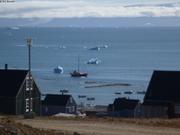Qaanaaq
Built sixty years ago, Qaanaaq (Thule in Danish) has today about six hundred inhabitants. Only small boats can enter the lagoon, in front of the village, however not so well protected from westerly and south-easterly winds. Vagabond dropped anchor in three meters of water, outside the lagoon, and is ready to set sail in case the wind is picking up. The next scientific team will board on August 6th, for two weeks, and part of the equipment was already waiting for us here in Qaanaaq. Hans is giving me the parcels. He is holding the local hotel ans is showing me proudly pictures from explorers and adventurers that stayed here before. Hans was two years old when his village was moved here, when the American Thule Air Base was built, in 1951.
As well as watching for missiles and communicating with satellites in orbit, the huge military base is supporting Arctic scientific research projects. So Vagabond is allowed to stop, and we could get some supplies and unexpected ways of entertainment! About a hundred and fifty Americans from US Air Force are working at Thule Air Base, which is mainly running with three hundred and fifty Danish and sixty Greenlandic. This stop was also a chance for a very good first contact with Canadian Coast Guards, escorting a supply ship with their ice-breaker Henry Larsen.
Before reaching Qaanaaq, a hundred kilometers further north, Vagabond stopped in front of two more abandonned villages, Moriussaq and Qeqertarssuaq. Strange feeling to enter a school-church, while everything is inside, except teacher, pupil or faithful.
No walrus seen on our way, but still many seals and birds.

